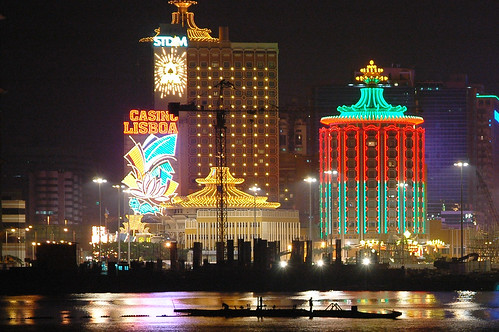But Macau is determined to shed its unseemly image. With the entire region booming, prosperity and buzz has crept into this once-sleepy territory. Foreign investments are repositioning Macau as a MICE (Meeting, Incentive, Conference and Exhibition) centre of international clout, while at the same time, Macau is being rebranded as a family oriented entertainment centre not unlike Las Vegas. Singapore should take heed, for results have been nothing short of phenomenal. Revenues have since outstripped that of Las Vegas Strip, making Macau the premier gambling centre of the world. 20 million visitors flood the territory of half a million every year. UNESCO, tellingly, granted the World Heritage Site status to Macau in 2005. A new chapter is being written, no longer with the blood of slain gangsters, but with the glittering gold of tourist dollars.
Which is the true face of Macau? The only way to find out was to pay a little visit to its fair shores. So when presented with the chance, albeit a very snap decision devoid of any logistical planning, I grabbed at it.
My logistical worries turned out to be unfounded. Snap trips in northern Europe leave you stranded in cold nameless towns. Snap trips in Macau leave you a comfortable cushion seat on one of the many ferries plying between Macau and HK, such were the frequencies of the ferries that they run round the clock all year round, for a mere HK$200!
Arriving at the ferry terminal on a balmy evening, my first concerns, as were in any foreign lands, were to locate a free map of the city, access the suitability of waiting lounges as makeshift hotels, and to check out availability of food. All concerns were ambly addressed. Tourist friendly indeed!

My first sights of the city as the ferry steams into harbour-- the neon lights from the casinos lending the harbour a shimmering and strangely comforting feel.
It's very easy to find your way around on foot. The waterfront perimeter, from the harbour in the east, all the way to the west, spans no more than 5 km. All self-respecting casinos, including Wynn and Sands, are located in this prime property. Wide boulevards (avinedas), all with Portuguese names, line the city. One such boulevard, Avenida de Amizade, links up the ferry terminal to the town centre.

Walking along Avenida de Amizade, I caught the silhouette of a nocturnal angler against the backdrop of Macau "The Floating Casino" Palace. I was to find the entire perimeter of the waterfront filled with anglers, young and old, but predominantly men, lying stealthily in wait for their catch. The Zhuhai must be teeming with fish, either that, or the local TV channels aren't terribly exciting.

The Macau Colosseum, a monument built in worship of the tourist dollar.

Before Vegas casinos appeared on the scene, old school casinos of smoky parlours and tough-looking pit bosses ruled the land. Here, the facade of Wynn squares off rather arrogantly against Casino Lisboa, the grand dame of the "nostalgic" era.

Wynn marks every passing hour with a resplendent display of water and fire works, and changes the face of the Macau gaming industry with a Vegas-style entertainment centre.
No comments:
Post a Comment